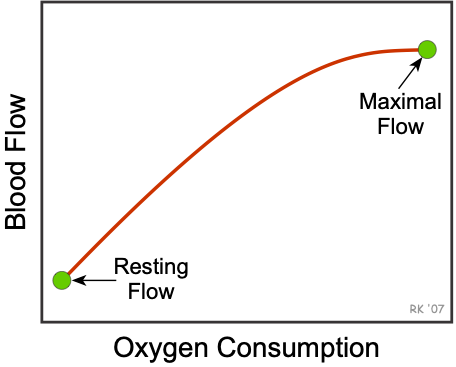Active Hyperemia
 Active hyperemia is the increase in organ blood flow (hyperemia) that is associated with increased metabolic activity of an organ or tissue. An example of active hyperemia is the increase in blood flow that accompanies muscle contraction, which is also called exercise or functional hyperemia in skeletal muscle. Blood flow increases because the increased oxygen consumption of during muscle contraction stimulates the production of vasoactive substances that dilate the resistance vessels in the skeletal muscle. Other examples include the increase in gastrointestinal blood flow during digestion of food, the increase in coronary blood flow when the heart rate is increased, and the increase in cerebral blood flow associated with increased neuronal activity in the brain. The figure shows that there is a resting flow associated with the basal oxygen consumption of the tissue. As the oxygen consumption increases, there is a near-linear increase in blood flow until the vessels achieve a maximally dilated state.
Active hyperemia is the increase in organ blood flow (hyperemia) that is associated with increased metabolic activity of an organ or tissue. An example of active hyperemia is the increase in blood flow that accompanies muscle contraction, which is also called exercise or functional hyperemia in skeletal muscle. Blood flow increases because the increased oxygen consumption of during muscle contraction stimulates the production of vasoactive substances that dilate the resistance vessels in the skeletal muscle. Other examples include the increase in gastrointestinal blood flow during digestion of food, the increase in coronary blood flow when the heart rate is increased, and the increase in cerebral blood flow associated with increased neuronal activity in the brain. The figure shows that there is a resting flow associated with the basal oxygen consumption of the tissue. As the oxygen consumption increases, there is a near-linear increase in blood flow until the vessels achieve a maximally dilated state.
The magnitude of active hyperemia responses differs among organs because of the relative changes in metabolic activity from rest and their vasodilatory capacity. Active hyperemia can cause up to a 50-fold increase in muscle blood flow with maximal exercise, whereas cerebral blood flow may only increase 2-fold with increased neuronal activity. Therefore, compared to resting conditions, skeletal muscle has a much greater capacity to dilate and increase flow than the cerebral circulation.
Active hyperemia can also be influenced by competing vasoconstrictor mechanisms. For example, sympathetic activation during exercise can reduce the maximal skeletal muscle active hyperemia compared to what would occur in the absence of sympathetic activation.
Active hyperemia occurs from a combination of tissue hypoxia and the generation of vasodilator metabolites, such as potassium ion, carbon dioxide, nitric oxide, and adenosine.
Revised 11/03/2023

 Cardiovascular Physiology Concepts, 3rd edition textbook, Published by Wolters Kluwer (2021)
Cardiovascular Physiology Concepts, 3rd edition textbook, Published by Wolters Kluwer (2021) Normal and Abnormal Blood Pressure, published by Richard E. Klabunde (2013)
Normal and Abnormal Blood Pressure, published by Richard E. Klabunde (2013)